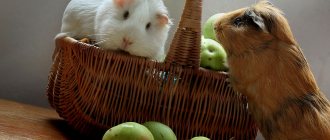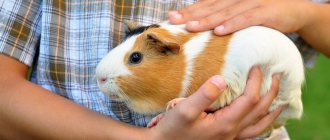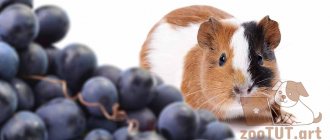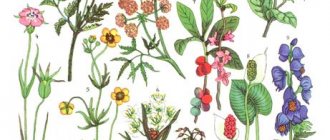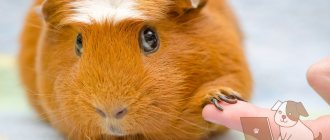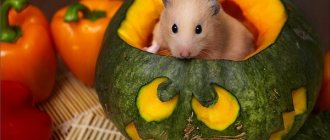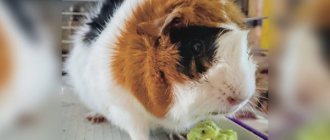Rough (solid) feed
Rough (solid) food is primarily hay, grain and special pellets (pelleted food, which is sold in pet stores).
You can easily do without the latter, but it is very convenient to use and helps out in many cases, especially in winter. Guinea pigs usually crunch with pleasure at such gourmet incas right there, like chickens in a backyard, they rush to the feeder, clinging to it from all sides until they find it and eat everything that they love most. Currently, ready-made, pre-mixed dry food granules have appeared on the market, specially prepared for guinea pigs, which contain added vitamin C. It must be taken into account that due to the addition of vitamin C, the food usually has a short shelf life, about 3 months. Such food must always be stored in a dry place and in tightly closed packaging, otherwise it will quickly become moldy and spoil. Good hay
is a so-called stimulant that prevents intestinal dysfunction in pigs. It should also be very fresh, not small or dusty and fresh-smelling. The hay should be without any coarse or large twigs, and for long-haired pigs, it is better to give the hay cut or rolled into a roll or tied. Otherwise, long hair gets tangled in the hay very easily.
Twigs
Twigs ¶
From: Svinni - April 12, 2007 0:17
Good evening! I read that pigs should be given twigs to chew on. And what branches can they use (which trees or bushes) Thanks in advance
Twigs ¶
From: Mystery - April 12, 2007 3:14 am
Good evening! I read that pigs should be given twigs to chew on. And what branches can they use (which trees or bushes) Thanks in advance. Apple trees can definitely be used, probably plums and cherries, but I know for sure lilacs can’t. In any case, I gave exactly these and everything was fine.
Twigs ¶
From: Lanka.zp - April 12, 2007 3:57 am
There are a lot of topics on the forum about branches, but what to do with leaves? I read that apple, currant, raspberry, etc. branches are given with foliage. But what about willow, birch, I don’t mean fruit trees? Today I cut a bunch of branches, I’m sitting, thinking whether to pick off the leaves or leave them - this is our first spring, we have no experience in such things.
Twigs ¶
From: Galina - April 12, 2007 4:54 am
You can: birch, ash, maple, apple tree (dry the branches), alder, pear, willow (all types), rowan, linden. They can be given to the pig “for free use.”
Avoid: tree branches that have seeds in their fruit, i.e. apricot, peach, cherry, plum, etc. (because if they have not been dried for at least 6 months, they may contain cyanogen glucosides, which cause intoxication); branches of coniferous trees; citrus branches like orange, lemon, tangerine, etc. (contain limonin).
Twigs ¶
From: Lanka.zp - April 13, 2007 2:27 am
You can: birch, ash, maple, apple tree (dry the branches), alder, pear, willow (all types), rowan, linden. You can put them “for free use” by the pig. “For free use” does this mean both branches and leaves?
Twigs ¶
From: Galina - April 13, 2007 5:45 am
For free use - this means that the twigs (with or without leaves) can always be at the disposal of the pigs, they do not need to be limited. Here’s another example for you, a statement from the forum: My pigs get plenty of hard feed and their bite is fine. In the summer, I stocked up on apple branches with leaves (one of my favorite treats) as an additional diet; in addition to the leaves, she also eats branches, nibbles them off and eats them, chewing them thoroughly.
Twigs ¶
From: Svinni - April 13, 2007 2:45 pm
Can pigs have cherry branches and leaves? And I didn’t quite understand something, can I have imiren or not?
Twigs ¶
From: Galina - April 14, 2007 0:49
Can pigs have cherry branches and leaves? And I didn’t quite understand something, can I have imiren or not? I don't know anything about lilacs. The only thing I can say is that I have never seen a single animal that would eat it, and I have never even seen caterpillars on it. Cherry branches may contain the same substance as the fruits inside in the pits - albeit in smaller quantities, and it is toxic. That’s why it is recommended to dry cherry branches (and all fruit trees with seeds) for six months before giving them to the pig.
Twigs ¶
From: L_enok - April 14, 2007 2:50
And I gave my pigs and the little pig before them apple tree branches with leaves and birch. They tore down the birch tree with buds and whole twigs, and from the apple tree there was bark and young leaves at the entrance))) It seems to me that the animals themselves will not eat something harmful to them, although of course, the risk in this case is not justified and it is better not to try. Give only what is absolutely possible.
Twigs ¶
From: Venus - April 14, 2007 2:29 pm
cucumbers
Most often, owners are interested in whether guinea pigs can eat cucumbers. These vegetables contain 2-6% dry matter - sugars, fiber, protein, some vitamins and microelements. 94-98% of the total mass of a cucumber is water, so this vegetable has little nutritional value. But, despite this, cucumber helps the rodent’s body digest other foods and absorb fats. You can give cucumbers to guinea pigs in small quantities and, preferably, your own, since poisoning often occurs due to the nitrates contained in purchased cucumbers. Overfeeding cucumbers can lead to digestive problems.
Fruits and berries
Can guinea pigs have bananas? A banana rich in potassium will benefit your guinea pig, but you should not give more than 1 piece per day.
The peel of the vegetable must be removed, as it is treated with substances hazardous to health (wax, chemicals, ethylene and pesticides). For safety, it is better to remove soft fibers from the fruit.
Can guinea pigs eat a pear?
Pears can be given with the peel, but without the seeds. The fruit is washed well and cut into pieces; the pig should be offered water along with it. Excessive consumption of pears due to their high sugar content can cause diarrhea.
Can guinea pigs eat kiwi?
Kiwi is a very healthy fruit for animals. It contains a large amount of ascorbic and folic acids. It is also rich in vitamins E, iron, calcium, magnesium and phosphorus.
Kiwi is given without skin in the form of small pieces. For your pet, you need to choose harder fruits. It is better to control the amount you eat. An increase in the dose of kiwi is permissible in autumn and winter, as well as when feeding females during pregnancy and lactation.
Can guinea pigs have oranges and other citrus fruits?
Can be used occasionally. But it is better for guinea pigs to get vitamin C from other foods, avoiding citrus fruits. Possible complications:
- oversaturation with vitamins;
- skin irritation;
- oxidation of urine.
Can guinea pigs eat apples?
Apples can be raw or dried. They have a balanced ratio of sugar and fructose (18:80%). It allows the pig to be active.
The fruit must be peeled and cut into slices. It is better not to give more than 3 pieces at a time.
Can guinea pigs eat strawberries, grapes and other berries?
Strawberries contain a sufficient amount of vitamin C to pay attention to the berry when choosing a treat for a rodent. You can also give strawberry leaves to animals.
- The pig might like grapes. You can offer the animal seedless grapes.
- Eating currants once a week will also not harm your pet.
- If you do not abuse it, you can offer the pig berries and raspberry leaves, berries, leaves and branches of blueberries, blackberries and sea buckthorn, and rose hips without seeds.
- Cranberries are given for medicinal purposes. It has an anti-inflammatory effect on the mucous membranes of the mouth, stomach, and bladder.
Serving Size
There are three apple-related factors to consider when feeding your guinea pig apples:
- High sugar content;
- A large amount of vitamins;
- High concentration of acids.
It is better to cut the fruit. All these components, if contained in excess, can lead to digestive disorders, irritation of the mucous membranes and deterioration of the pet’s condition.
In this regard, you should feed your guinea pig fresh apples no more than three times a week. Moreover, it is worth giving it 2 - 3 slices, depending on the size of the fruit.
Dried fruits can be given in a bowl - every day in the morning, 3 - 4 slices.
But you cannot collect these seeds, store them separately for a long time and pour them out to your pet by the handful. The fact is that the skin of the seeds contains cyanic acid. Its concentration increases over time, making them poisonous. A large number of seeds, especially after long-term storage, lead to serious poisoning of the body and even the death of the pet.
Thus, a guinea pig can be fed fresh apples three times a week, and dried apples every day in the morning. Do not give soaked or compote-boiled apples. Apple seeds can only be given from fresh fruit in a few pieces; the seeds cannot be collected and stored separately, as extremely toxic cyanide acid accumulates in them.
Poisonous plants
When going to collect herbs for your beloved pet, you need to remember that there are a number of poisonous plants that not only cause poisoning, but also lead to death.
Plants that are poisonous and dangerous to guinea pigs include:
- Fighter,
- Arum,
- white acacia,
- Common aloe
- Common and lemon geraniums,
- All types of ferns,
- All types of lilies,
- Sorrel,
- Nightshade,
- Henbane,
- Lilies of the valley,
- All varieties of narcissus,
- Hyacinths,
- Celandine.
The following are considered dangerous for animals:
- Bay leaf,
- Gorse,
- All types of wisteria,
- Yew,
- All varieties of ivy,
- Deren,
- Common broom,
- Dogwood and all varieties of honeysuckle.
Nightshade is a very poisonous plant and leads to death.
Of the tree species it is strictly forbidden to feed:
- Thuja and oleander sprigs,
- Biryuchina,
- Juniper shoots and roots,
- Berries, leaves and twigs of elderberry,
- mistletoe,
- Leaves, shoots and twigs of hellebore and belladonna.
Rules for feeding guinea pigs
- Feed at the same time, which the animals quickly get used to.
- Do not give too much food; remove any leftover food from the cage (except hay).
- Green food, vegetables and fruits must be fresh.
- Always provide hay and green food in a feeder.
- Wash fruits, cucumbers and tomatoes thoroughly, but do not peel them. It is better to peel sweet peppers, as the skin is difficult to chew.
- Lettuce leaves absorb harmful substances, so it is recommended to rinse them thoroughly and dry them.
- Fill the drinking bowls with new, settled water twice a week.
- From time to time, put something in the cage to chew on.
A varied diet is very important for a guinea pig, including not only dry food, hay and grass, but also fresh vegetables, herbs and fruits. But not all foods will benefit these pets, so when feeding them the question arises: “What vegetables can guinea pigs eat?” Let's look at this issue.
To provide your pet with all the necessary vitamins and microelements, you need to include fresh vegetables and fruits in its diet. They should be given in small quantities, about 80-120 grams per day, washed thoroughly before feeding and cut into pieces, but not grated. The pieces should be small so that the pig can eat them completely. Uneaten pieces must be immediately removed from the cage and thrown away, preventing them from rotting. Spoiled and rotten food should not be fed to guinea pigs.
It is best to use products grown in your own garden or garden. But if you don’t have your own plot of land or cottage, then it is advisable to buy vegetables, herbs and fruits in season, avoiding products grown with the use of pesticides and treated with various drugs.
Let's figure out what vegetables guinea pigs can eat and how they are good for your pets.
Diet
Depends on the physiological state. So, adult animals are always fed in the morning and evening at the same time. For pregnant pigs, feed is increased to 4 times a day.
It is important to understand that a hunger strike is unacceptable for rodents, as is a sudden change in diet. Any new product is introduced gradually and in small doses
Overeating also has a negative effect - diseases of the intestinal tract and obesity will be ensured.
An approximate diet of what guinea pigs eat per day is presented in the tables.
Possible diet depending on the time of year (per day)
| Type of feed | Winter | Spring | Summer | Autumn |
| Vegetables, city | 100 | 100 | 100 | 100 |
| Root vegetables, | 30 | 30 | 20 | 20 |
| Fresh greens, | — | — | 300 | 300 |
| Seno, city | 10-20 | 10-20 | — | — |
| Bread, Mr. | 20-30 | 20-30 | 10-20 | 10-20 |
| Grain, city | 40 | 40 | 30-40 | 30-40 |
| Milk, ml. | 20 | 20 | 20 | 20 |
Nutrition for young and adult guinea pigs (daily ration)
| Adults | Young | |
| Grain, city | 30-40 | 20 |
| Bran, Mr. | 15 | 10 |
| Seno, city | 60 | 30-40 |
| Green, city | 500 | 200-300 |
| Root vegetables, | 100 | 50 |
| Milk, ml. | 15 | 5-10 |
If you answer the question of which food is better, then experts do not have a common opinion on this matter. Many are inclined to think that this is oat bran, carrots and beets, as well as hay in winter or grass in summer. Other professional breeders are not against constantly feeding animals with high-quality and well-balanced factory-made feed.
Watermelon
Guinea pigs can be given a little watermelon during the summer season. Try to give ripe pulp, and it is advisable not to give the white part closer to the rind, since it is in this part that nitrates accumulate. For the same reason, pigs should not be given early vegetables. Watermelon is a diuretic, so indulge your pet with it infrequently.
The same goes for melon. This vegetable is given from your own garden or purchased in season. It is also not recommended to give melon frequently; it is very sweet and can contribute to the development of diabetes.
We tried to consider in as much detail as possible and give answers to the question “What vegetables can guinea pigs eat?” As you can see, most vegetables are not only possible, but also should be given to guinea pigs. The most important thing is a properly formulated and balanced diet for your pet, including products grown without chemicals. To keep your guinea pig healthy and cheerful, stick to proper nutrition and your pet will thank you with its playful behavior and healthy appearance.
So, we have dealt with the question of what vegetables can guinea pigs eat, but we described in this article whether your pet can eat grass. You may be interested in this information.
https://nalugah.ru/zhivotnovodstvo/morskie-svinki/chem-mozhno-i-nelzya-kormit-morskuyu-svinku.htmlhttps://msvinkam.ru/pitanie/chem-kormit-morskuyu-svinku.htmlhttps:// moy-homyachok.ru/morskie-svinki/kakie-ovoshhi-mozhno-morskim-svinkam.html
How to choose the right mating partner
Here's how to choose the right partner for mating:
The best age for a male is from eight months to a year. It’s better not to let old “pigs” into breeding.
It is very desirable that the “groom” belongs to the same breed or at least variety. In this case, there will be much fewer problems with childbirth and pregnancy.
The optimal weight is from 0.7 to 1 kg. The female, by the way, should weigh about the same. The animal should be neither obese nor emaciated.
https://www.youtube.com/watch?v=GsW_Y5o5aZM
Finally, the pet must be completely healthy. To make sure of this, it is advisable to have the “bride and groom” examined by a veterinarian.
It is highly desirable that the animals be approximately the same in character. Two fighters can seriously damage each other’s skins; if you pit a melancholic and active pet, normal mating will not work either.
About the benefits of succulent feed
Nettle
Common stinging nettle has a number of beneficial properties and vitamins. It contains a lot of vitamin C, carotene, B vitamins and carotene. Fresh or dried nettle is a good natural vitamin concentrate. Young nettle leaves are also rich in protein, starch, chlorophyll, carbohydrates and iron salts, potassium and copper, manganese and titanium, nickel, many types of tannins and organic acids. Another advantage of nettle is that it is nutritious. Nettle leaves and shoots contain a large amount of proteins, fiber, and fats.
The leaves can be fed whole, or they can be made into powder and added to the main grain or concentrated feed. It is best to harvest nettles before flowering begins. Young shoots are mowed or only leaves are collected. Dry without pre-washing in a well-ventilated area, but out of direct sunlight.
Dandelion
This common and familiar plant is very useful for guinea pigs and in the summer it must be included in the animal’s diet. The leaves and roots of the plant are fed. Dandelion leaves are very rich in carotenoids, vitamin C, vitamins B and P. Dandelion leaves are good to use to improve digestion in animals, as well as to increase appetite. Dandelion roots are rich in sugar, inulin, and malic acid.
Spinach
Young spinach leaves are suitable for feeding. Spinach is also a source of large amounts of vitamins and proteins, iron salts, calcium and phosphorus. Just one hundred grams of spinach contains more than 700 mg of potassium.
Spinach can be fed not only fresh, but also dried and even frozen.
Cabbage
Headed cabbage is suitable for feeding fresh. Red cabbage is considered more nutritious and rich in vitamins. White and red cabbage is rich in vitamins C, carotene, B vitamins and iodine, pantothenic acid and many salts important for animal health. However, do not forget that cabbage leaves cause fermentation and gas formation in the intestines, so it is not recommended to feed a lot of cabbage leaves per day. Brussels sprouts can also be used to feed guinea pigs. It is rich in ascorbic acid, proteins, carotene, vitamins and salts of sodium, phosphorus and iron, as well as iodine and potassium.
Broccoli is also suitable for feeding. This type of cabbage is nutritious and high in sugar, carotenes, choline, and methionine. Broccoli is very rich in calcium. A big plus of broccoli is that it can be frozen and fed even in winter.
Lettuce leaves
Lettuce is a favorite food of guinea pigs. Regular leaf lettuce sprouts quite quickly and forms rosettes, so many breeders even grow it in pots at home. Lettuce leaves are rich in sugar and metals important for the guinea pig’s body:
Lettuce leaves contain almost all known vitamins and folic acid. Regular feeding of lettuce helps improve digestion and has a good effect on the pig's metabolism and appearance.
Parsley and dill
Our usual parsley and dill are high in vitamin C and carotene. Dill is especially recommended for guinea pigs during pregnancy and nursing. Dill not only increases milk production, but also improves the nutritional quality of milk. It is recommended to feed parsley to young animals and guinea pigs during the molting period, as well as after illness.
Pet diet
In addition to vegetables, pigs eat dry food.
Guinea pigs are fed a specially formulated dry food, but eating vegetables and fruits is an important part of their diet. The daily dose of vitamin C is from 10 mg/kg to 30 mg/kg. When a guinea pig is pregnant or sick, the rate increases to a minimum of 30 mg/kg per day.
A small amount of grass, juicy tops and various vegetables are introduced into the daily food intake for rodents. In addition to hay and pelleted feed, add some fresh fruit. Good for supplementary feed:
- radish leaves;
- spinach;
- parsley;
- dandelion leaves.
In the autumn-winter period, it is recommended to introduce succulent food into the animal’s diet. A rodent should consume about 80-100 g of succulent food per day. This is only 20% of the daily requirement. The diet of an adult pet should be as varied as possible.
Other products
Can guinea pigs eat bread? It's better not to give.
Fresh yeast bread takes a long time to digest and causes fermentation in the animal’s stomach. White bread causes bloating. Your pet can eat stale bread, but not often. Dried bread with seeds, sesame seeds and raisins can sometimes be offered to your pet as a treat.
Can guinea pigs eat nuts and seeds?
Nuts and seeds are among the allowed foods, but can cause obesity if their consumption is not limited. It is better to offer your pet almonds, walnuts or hazelnuts.
The seeds contain many components useful for the animal: fatty acids, calcium, sodium, phosphorus, proteins and vitamins. It is better to give peeled seeds and make sure that they are no more than 15% of the total feed.
What nuts are allowed to give to a rodent?
Opinions are divided regarding nuts. Some owners are of the opinion that this is an unnecessary product, because animals do not feed on them under natural conditions. Others consider the kernels to be an excellent treat, provided they are kept in moderation, but recommend offering them to mobile and active animals.
Whether guinea pigs need nuts in their diet is a controversial issue.
The kernels must also be raw. The most suitable nuts for guinea pigs are walnuts and hazelnuts. Many pets enjoy eating almonds. But there is an opinion that the dose of hydrocyanic acid contained in it may be toxic to the pet.
It is better not to consider pine nuts and peanuts as treats - these varieties contain too high a percentage of fat and can harm the health of the animal. If your pet is lazy and prefers to rest or sit in one place for most of the time, then it is better to exclude any types of nut kernels so as not to provoke obesity in the animal.
For useful information on whether it is possible to treat your pet with baked goods, read the article “Is it possible to give bread to guinea pigs?”
Is it possible to give a guinea pig nuts and seeds 5 (100%) 3 votes >Is it possible to give a walnut to a guinea pig
Cabbage
Can guinea pigs eat cabbage? There is an opinion that cabbage is contraindicated for guinea pigs, that this vegetable causes problems with the digestive system. In fact, cabbage is a healthy vegetable containing a lot of protein, vitamins and microelements.
If you have a healthy pet, not prone to bloating, and you gradually and in small quantities introduce cabbage and other succulent foods into the diet, then your guinea pig will not have problems with digestion. And if you do not follow your pet’s diet and immediately introduce new foods without accustoming your pig to them, then problems with the intestines cannot be avoided. Small amounts of cabbage, cauliflower, Brussels sprouts, broccoli and kohlrabi can be fed infrequently. Do not feed early, greenhouse cabbage.
What to avoid
When feeding plant foods, you should not exceed the permissible limits.
This refers to excessive consumption of sweet fruits. So, an abundance of apples and grapes in the diet can cause an upset stomach in a guinea pig. An excess of cabbage (white cabbage, Chinese cabbage, broccoli and other cruciferous plants) creates problems in gas formation in the digestive tract. Unripe or, conversely, overripe vegetables and fruits should be excluded from the diet. They are unconditionally excluded if the slightest initial signs of decay are detected.
Following these simple rules will help maintain the necessary balance of nutrients in the pig’s body. This means that the animal will grow up healthy, active and delight all household members with its love of life!
List of prohibited foods for guinea pigs
List of products that should not get into the animal’s feeder:
- raw potatoes and dishes made from them;
- any dairy products, including butter, kefir, yogurt, cottage cheese;
- marinades and smoked products;
- fresh cucumbers and tomatoes purchased out of season;
- any confectionery products, including sweets, cakes, marshmallows and chocolate;
- raw or cooked meat and fish;
- eggs in any form;
- sorrel and rhubarb;
- green onions, onions, garlic and mustard;
- mushrooms in any form;
- horseradish (leaves and roots);
- radishes and radishes;
- salt, sugar, honey;
- coffee, sweetened tea;
- bread and pasta.
It is dangerous to give branches of some trees and shrubs, for example, oak, rowan, pine, spruce, and prickly gooseberry. To avoid mistakes, it is better to offer shoots of apple, pear, currant, cherry, hawthorn and raspberry as twig food. You need to especially carefully monitor your pig's diet after giving birth. If the female comes across a toxic product, the babies may be left without a nursing mother.
You should not conduct dangerous experiments by offering animals exotic products from the supermarket. It must be remembered that the nutrition of rodents should be as close as possible to natural conditions. In their homeland in South America, guinea pigs feed exclusively on leaves, roots, fruits and branches of trees, meadow grasses, stems, leaves and inflorescences of shrubs. In the wild, they eat very little to keep themselves in good physical shape. Otherwise, they will become easy prey for predators.
Pigs are herbivores, so in nature they do not eat food of animal origin. They cannot eat it at home either. Therefore, it is better not to offer animals milk and dairy products (cheese, cottage cheese, butter), meat, fish, poultry and eggs. If you need to feed the babies yourself, it is better to use a dairy-free formula for babies.
Catering
To understand what to feed a guinea pig at home, you need to familiarize yourself with the physiological characteristics of this rodent. His body is structured differently from that of a human. The main difference is that intestinal motility in a rodent is much weaker than in humans. Accordingly, most foods that are palatable to humans simply cannot be given to rodents.
To properly feed your furry friend, think about what he eats in the wild. The diet of a domesticated rodent should not differ radically from the diet of a rodent that lives in the wild. And in the wild it feeds on various plants, grains, hay, roots, and some fruits and vegetables.
When preparing a diet for your pet, you should take into account the individual characteristics of the animals, each of which has its own preferences. Some rodents love apples, while others prefer carrots, some like succulent food, while others like hay.
This does not mean that you need to feed your pet only the foods that he likes. The diet should be well thought out and balanced. But, if possible, give preference to those products that the rodent likes. Also take into account that along with his favorite food, it is advisable to feed your ward food that he does not like, but which should be present in the diet.
Diet
Before moving directly to the description of permitted and prohibited foods, let’s make a reservation about how many times a day to feed a guinea pig. Rodents need to be fed often, but little by little. It is advisable to fill your pet's feeders 4 times a day. It is advisable to feed your ward at the same time. You should not put in a lot of food, since the small fluffy rodent is prone to stockpiling. Accordingly, the pet will try to hide food that the pet does not eat. Make sure that nothing is left in the feeders after feeding.
If you give fruits or vegetables, then after feeding, remove all the leftovers, and take the time to wash the feeders. If you do not properly care for your pet, and keeping the dishes clean is also part of the care, then your pet will certainly have stomach upsets caused by sour food. Rodent feeders should be washed without using detergents.
If you introduce a new product into your diet, do it carefully. Rodents are very sensitive to changes in food. When giving any product for the first time, observe your pet. If he shows signs of gastrointestinal dysfunction, immediately eliminate the new product from the diet.
Grain feed
A guinea pig needs to eat at least 20% grain per day. Grain food for rodents is sold in any pet store. The finished product usually includes:
- barley;
- oats;
- millet;
- sunflower seeds;
- corn grains.
In addition to grain, prepared feeds may include vegetable granules and vitamin supplements.
Dry pet food is easy to prepare yourself; you just need to buy different types of grains on the market and then mix them. But you need to take into account that the main ingredient is oats; guinea pigs eat it more readily than other grains. Solid grain food should always be present in the diet of rodents. Animals need it to grind down their continuously growing teeth. If a rodent eats only raw and soft food, then its incisors become unnaturally elongated and interfere with the ability to absorb food. As a result, the animal dies from starvation.
Water
Every living thing needs water, and so do guinea pigs, although there are some guinea pig breeders who claim that with the proper amount of greens, guinea pigs do not need water. This statement is erroneous and incorrect. In summer, pigs need plenty of drinking water, especially pregnant and lactating ones.
Drinking water must be changed every day. It is advisable not to use a drinking mug, as the water in it spoils faster; it is better to use drinking bottles. But on very hot days, pigs can happily stand around an open drinking bowl and dip their front paws into it. This is very refreshing and cool for our dear pets.
What else can you feed your guinea pig?
We have figured out the beets: you can and should give them if no signs of allergy are noticed. But, of course, the animal’s diet must be varied, and, as they say, you can’t go far on beets alone. What else can you give your pet?
- Cucumbers, which are rich in fiber, proteins, vitamins and microelements, contribute to a good digestion of food in the body, as well as the absorption of fats.
- It is better to give zucchini “young”, as they contain more useful substances.
- Tomatoes are only ripe, since green ones contain a toxic substance - solanine, which is destroyed precisely when the fruit ripens. Vegetables are highly digestible, but when overeaten they cause diarrhea.
- Green peas with pods.
- Carrots are considered one of the healthiest vegetables, which have a beneficial effect on metabolic processes in the body. Thanks to useful elements, vision, hearing, skin and coat condition improves.
- Cabbage of different varieties, but in small quantities. With a balanced diet, it improves digestion. Also, the properties of cabbage can boost immunity. However, if there is an excess of white cabbage in the diet, bloating may occur.
- Sweet bell pepper without seeds.
- Swede.
- Corn is useful in the form of fresh and dry stalks and leaves.
- Pumpkin is very healthy and rich in fiber, proteins, sugar, vitamins, macro- and microelements. Before feeding, there is no need to peel the vegetable, since the peel contains useful elements, and there are also many minerals in the seeds, which has a beneficial effect on the fight against helminths. Taking pumpkin seeds is a preventive measure to destroy pathogens.
- Jerusalem artichoke can be given in the form of leaves, flowers, which contain fiber and essential amino acids such as lysine, leucine and arginine. The root vegetable itself contains a large amount of inulin, which is a natural analogue of insulin, which is why this herbaceous tuberous plant is recommended to be given to guinea pigs prone to diabetes. But it’s worth knowing that the young tubers of this root vegetable contain starch, so you don’t need to give Jerusalem artichoke often. It belongs to concentrated feeds, which in large quantities can cause intestinal upset.
- It is recommended to give watermelon exclusively in summer and only ripe pulp. It is better not to give the white part, which is closer to the crust, since it is in this part that nitrates accumulate. It is also worth considering the fact that watermelon is a diuretic berry, so you should not abuse it.
- Melon can also be given seasonally and in small quantities; it is very sweet and can provoke the development of diabetes.
- Celery can be given in any form: stems, leaves and roots; it is enriched with vitamins B, PP, E, C, A and contains phosphorus, zinc, potassium, calcium, iron and magnesium. Before use, it must be washed thoroughly, especially the root.
- Banana (you can give one a day) after peeling it, which contains substances hazardous to health - wax, chemicals, ethylene and pesticides.
- The pear can be given with the skin, but without the seeds; be sure to wash the fruit and cut it into small pieces. Excessive consumption may cause diarrhea.
- Kiwi is a very healthy fruit; it contains large amounts of ascorbic and folic acids, vitamin E, iron, calcium, magnesium and phosphorus. It is better to choose firm fruits.
- Apples and grapes.
- Cranberries can be given for medicinal purposes; they have an anti-inflammatory effect on the mucous membranes of the mouth, stomach and bladder.
Thanks to such a variety of permitted vegetables, you can change the menu, which will definitely please your pet. Most importantly, you need to properly formulate and balance the diet so that your pet remains healthy and cheerful. Don’t be afraid to update your diet; the more you change feeding, the faster you will learn about your pet’s tastes.
Don’t forget that guinea pigs are herbivores, so to improve the rodent’s digestion, gradually reduce the amount of granulated food, replacing it with natural products
You also need to remember one important rule: your guinea pig only drinks regular clean tap water, so avoid filtered water completely.
is this possible for pigs?
can pigs do this ¶
From: Danary - January 21, 2011 12:52 pm
Tell me, is it possible to give pigs: celery greens, cilantro?
can pigs do this ¶
From: Riki-Tiki - January 21, 2011 1:41 pm
It is possible and even necessary. Only summer ones, grown naturally, and not winter ones in pots, grown with hydroponics and pesticides. True, not all pigs eat celery and cilantro because of their specific smell.
can pigs do this ¶
From: Marusya's mother - January 31, 2011 1:38
Mine loves cilantro, but not celery, even if the carrots lie next to the celery, then they won’t eat it unless they really want to eat it
can pigs do this ¶
From: Roni4ka - January 31, 2011 9:59 am
My celery is killed for my dear soul! But I was afraid to give cilantro, they wrote somewhere that it was forbidden.
can pigs do this ¶
From: susvinki - January 31, 2011 7:28 pm
can pigs do this ¶
From: Tasilda - January 31, 2011 8:23 pm
can pigs do this ¶
From: susvinki - February 1, 2011 8:13 am
Now this is no longer entirely true; many women resell bunches of dill, parsley and cilantro not from their gardens, but from the same greenhouses, especially in cities. This is the same situation as drunks and grandmothers walking on electric trains and selling greens, vegetables and fruits. Obviously, they don’t grow it themselves, either they buy illiquid goods in bulk from stores, or they choose from city landfills what they throw out of supermarkets. It is easier for large stores to throw out a box of spoiled vegetables and fruits than to spend money on sorting. Here the drunks and the money choose, launder and resell. Nowadays, few people grow and sell their own. I have a dacha in the village and every year I see that no one plants anything, it’s easier to buy flowers in the store, even the notorious bunch of dill and radishes.
can pigs do this ¶
From: Tasilda - February 1, 2011 11:11 am
We have 80-year-old grandmothers and grandfathers in our market who simply don’t have the strength to wander around the shops and choose illiquid goods. And the greenery is clearly its own - smaller and curlier.
( And country eggs with an orange yolk, too, would you say, from the store?
).
can pigs do this ¶
From: AlpenGold - February 1, 2011 11:40 am
I always took greenflies from “my” grandmothers (in spring and autumn). We always have them there. In winter with pickles, in warm weather - with fresh bunches and cucumbers. I buy almost everything. What kind of mint do they have?
Fruits and berries
Can guinea pigs have bananas? A banana rich in potassium will benefit your guinea pig, but you should not give more than 1 piece per day.
The peel of the vegetable must be removed, as it is treated with substances hazardous to health (wax, chemicals, ethylene and pesticides). For safety, it is better to remove soft fibers from the fruit.
Can guinea pigs eat a pear?
Pears can be given with the peel, but without the seeds. The fruit is washed well and cut into pieces; the pig should be offered water along with it. Excessive consumption of pears due to their high sugar content can cause diarrhea.
Can guinea pigs eat kiwi?
Kiwi is a very healthy fruit for animals. It contains a large amount of ascorbic and folic acids. It is also rich in vitamins E, iron, calcium, magnesium and phosphorus.
Kiwi is given without skin in the form of small pieces. For your pet, you need to choose harder fruits. It is better to control the amount you eat. An increase in the dose of kiwi is permissible in autumn and winter, as well as when feeding females during pregnancy and lactation.
Can guinea pigs have oranges and other citrus fruits?
Can be used occasionally. But it is better for guinea pigs to get vitamin C from other foods, avoiding citrus fruits. Possible complications:
- oversaturation with vitamins; skin irritation; oxidation of urine.
Can guinea pigs eat apples?
Apples can be raw or dried. They have a balanced ratio of sugar and fructose (18:80%). It allows the pig to be active.
The fruit must be peeled and cut into slices. It is better not to give more than 3 pieces at a time.
Can guinea pigs eat strawberries, grapes and other berries?
Strawberries contain a sufficient amount of vitamin C to pay attention to the berry when choosing a treat for a rodent. You can also give strawberry leaves to animals.
- The pig might like grapes. You can offer the animal seedless grapes. Eating currants once a week will also not harm your pet. If you do not abuse it, you can offer the pig berries and raspberry leaves, berries, leaves and branches of blueberries, blackberries and sea buckthorn, and rose hips without seeds. Cranberries are given for medicinal purposes. It has an anti-inflammatory effect on the mucous membranes of the mouth, stomach, and bladder.
Vegetables
Can guinea pigs have radishes?
It is permissible to use only radish tops. The root vegetable contains essential oils that can cause irritation to the mucous membranes and respiratory tract of the animal. The vegetable also causes bloating. Therefore, it is not recommended to give radishes to pigs.
Can guinea pigs eat celery?
Celery can be given in any form - stems, leaves, roots. This vegetable is included in many dry food for rodents. Celery is enriched with vitamins B, PP, E, C, A and contains phosphorus, zinc, potassium, calcium, iron and magnesium. Before eating, celery must be washed thoroughly, especially the root.
Can guinea pigs eat tomatoes?
Ripe fruits can be included in the food. Tomatoes are well absorbed by animals and contain vitamin C and carotene, which are beneficial for their body. Green tomatoes contain solanine, which can negatively affect your pet’s health.
Too many tomatoes in an animal's menu can cause loose stools.
Can guinea pigs eat cabbage?
Cabbage can be included in the animal's diet. Cabbage contains many vitamins and other substances necessary for pigs:
- ascorbic acid;
- B vitamins;
- vitamins of the PP group;
- folic acid;
- sulfur;
- calcium;
- potassium;
- phosphorus;
- amino acids;
- microelements.
The vegetable is able to keep the animal’s fur in excellent condition and strengthen its immunity. The top dried leaves should be given. It is preferable to feed guinea pigs Chinese cabbage and broccoli. White cabbage can cause bloating.
Can guinea pigs eat potatoes?
Green and sprouted potatoes are contraindicated for guinea pigs. Raw vegetables can be given occasionally, cut into small pieces. Boiled potatoes can be offered to your pet separately or added to grains and other foods.
The vegetable contains solanine, which can harm the health of the animal if the pet eats too many potatoes. The pig will become passive and catch cold quickly.
Can guinea pigs eat beets?
Beetroot contains many substances useful for animals: vitamins C, A and B, potassium, magnesium, phosphorus, iron. In excess, the vegetable contains fiber, so it acts on the animal’s body as a laxative. Store-bought root vegetables may contain nitrates, which are very harmful to the small body of guinea pigs. It is better to offer your pet homemade crops. The composition also contains a large amount of oxalic acid, so it is better to limit the consumption of this product.
It is recommended to give beets starting from 2 months; they are especially useful in winter and spring, when there are no fresh vegetables. The daily dose should not exceed 200 g, and it is better to exclude beets from the diet of pregnant and lactating pigs so as not to provoke an upset stomach. Beets turn stool and urine red, so if your animal has eaten them, don’t be alarmed by such changes.
Can guinea pigs eat pumpkin?
Pigs can be given all varieties of pumpkin that humans eat. For the digestion of herbivorous animals, such a product will be familiar and useful. Pumpkin contains vitamin C, calcium and phosphorus necessary for rodents. It should be borne in mind that this low-calorie vegetable will not be able to saturate the pig completely, so it is better to give pumpkin to guinea pigs as a treat.
Can guinea pigs eat bell pepper?
Another storehouse of ascorbic acid is bell pepper. Before use, the vegetable must be thoroughly washed and chopped, and the seeds removed. It is better to give the product together with dry food.
Green peppers containing solanine should not be given to animals, as should peppers in the form of hot seasonings. Spicy foods will damage the mucous membranes.
Can guinea pigs eat cucumber?
Cucumbers don't have as many nutrients as other vegetables. You can offer your pet a cucumber. The vegetable can harm your pet's health by causing digestive problems only if consumed in large quantities.
Healthy Supplements
The most common dietary supplement is vitamin C, which is diluted in drinks. It is not produced in the body on its own, but if the basic feeding rules are followed, guinea pigs receive it in sufficient quantities from fresh vegetables and feed mixtures. Vitamin C can be used as a supplement only as prescribed by a ratologist; usually such a need arises if we are talking about a weakened stomach or a prolonged period of artificial feeding.
And hay. During the gardening season, a caring owner wants to please his pet with crunchy, healthy and juicy gifts from the garden. Therefore, the question arises as to whether it is possible to give guinea pigs tomatoes and cucumbers.
Fresh tomato is a storehouse of biologically active substances that benefit the animal’s body. Pectins, amino acids, vitamins A and C - and this is not a complete list of components contained in the product. You can offer tomatoes to guinea pigs, but only in the following cases:
- they are thoroughly washed and there are no signs of rot on them;
- there is no doubt about the maturity of the gardening gift;
- The harvest is harvested from our own garden, so you can be sure of its quality and safety.
Tomato is offered to the animal in small quantities - a few thin slices without oil, sour cream and other additives per feeding will be enough. Overfeeding with tomatoes provokes diarrhea and deterioration in general health.
Tomatoes can be given to guinea pigs only without tops
Important! Under no circumstances should you introduce unripe fruits into your pet’s diet, as they contain solanine, a toxic substance that causes the death of the animal! Tomato tops are also on the list of prohibited foods for rodents.
